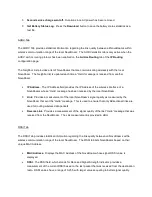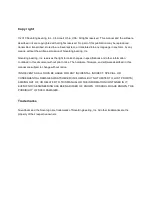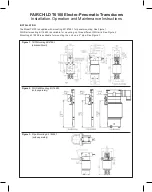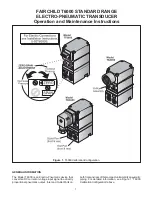
network communication overhead. Larger hello interval values decrease the wireless network’s
responsiveness to routing changes but reduce excessive wireless traffic in the process. This
value is measured in seconds and has a default value of 30 seconds.
•
Allowed Hello Loss. The Allowed Hello Loss value determines the number of consecutive hello
messages that, when missed, constitutes a link failure. The default value is 2.
•
Net Diameter. The Net Diameter parameter determines the maximum of number of wireless hops
between the source and destination nodes. This value has a default setting of 10 hops.
•
Node Traversal Time. The Node Traversal Time value provides an estimate of the time required
for a packet to traverse one wireless hop. This value affects how long a NovaRoam waits before
resending a route request packet. This value is measured in milliseconds and has a default value
of 150 msec.
•
Quality Constant. The Quality Constant parameter controls how quickly neighbor signal quality
values can change in order to help determine whether a decreased signal quality is a temporary
or permanent condition. A value of 0 will cause the radio to make routing decisions based on the
signal quality of the most recent packet received. A value of 10 will cause the radio to make
routing decisions based on the average of the last 10 received packets. Therefore, higher values
make routes more resilient to temporary changes in the wireless environment. The default value
is 3.
•
Link Threshold. The Link Threshold value determines the signal level above which all routes will
be treated as equal. If multiple equal routes are available, the route with the fewest number of
hops will be used. All routes with signal qualities that fall below the link threshold will use the
signal quality of the total route as the deciding factor in the route determination process. The
default value is -77 dBm.
•
Route Refresh Time. Once a route has been established, periodic route updates are broadcast
to the wireless network. The Route Refresh Time determines how frequently route update
messages are broadcast. The default value is 30 seconds.
•
Enable AODV Gateway. This feature allows a NovaRoam in a network to act as a gateway
between the wireless network and the Internet or other routable network. Placing a check mark in
the Enable AODV Gateway checkbox enables this feature and provides the additional
configuration options detailed below. The Enable AODV Gateway option should only be enabled
on the NovaRoam that will act as the gateway for the rest of the wireless network.
•
Apply. Saves changes made to the configuration of the Ad Hoc Routing Tab. Changes will not
be saved if you change to a different configuration tab without first pressing the apply button.
Enabling the AODV Gateway feature provides several new configuration options to the Ad Hoc Routing
Tab of the NovaRoam Client tool.










































